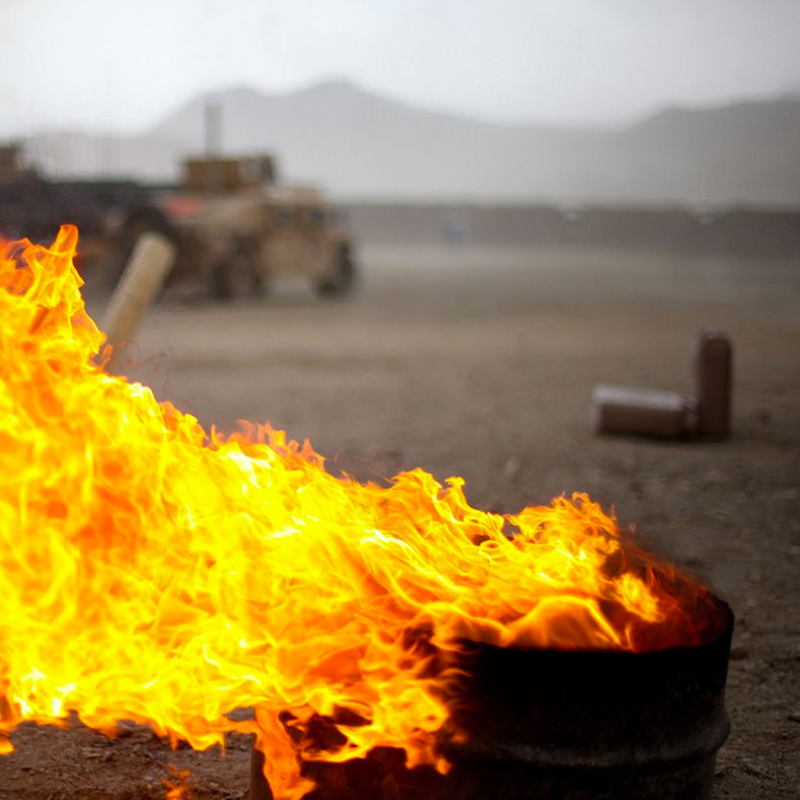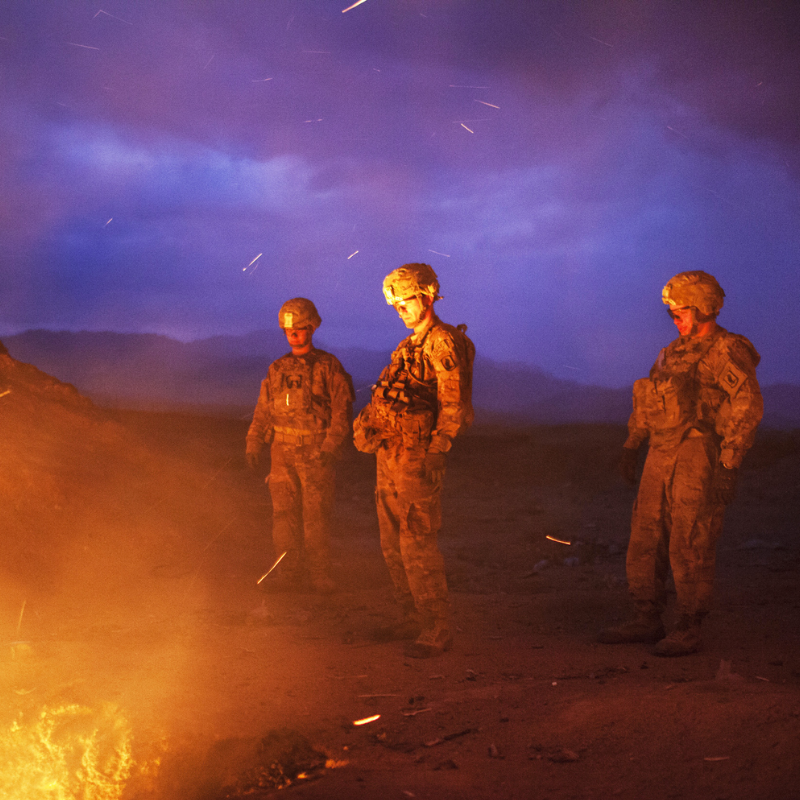IT'S MORE TO US, IT'S PERSONAL
The Dangers of Military Toxic Exposure: Burn Pits
While it’s difficult to get folks to agree on much these days, most would agree that joining the United States military involves accepting many innate risks, especially when it comes to combat. In fact, most, if not all service members, will freely admit that they are prepared to face the countless threats combat presents including illness, injury, and even death.
However, the truth is that risking life and limb in combat is only part of the equation. What about threats that aren’t so obvious or widely known? Health risks that have nothing to do with hostile forces, terrorist attacks, or enemy fire… health risks that possibly could have and should have been prevented?
These often unforeseen, unknown dangers arise from toxic contamination within the everyday work and living environments of those service men and women. The potential for environmental hazards is endless, but a few of those hazards, in particular, are recognized by the Department of Veterans Affairs as “military toxic exposures.”
The VA concedes that veterans who served in specific areas during qualifying time-frames may have suffered some sort of “toxic exposure” and that they are more likely to develop certain illnesses as a result. These so-called “presumptions” give rise to “presumptive service connection,” meaning a condition is presumed to be related to a veteran’s military service if other precise criteria set forth by the VA are met. Those veterans may be entitled to compensation for their illnesses.
COMMON MILITARY BASE TOXIC EXPOSURES
Few people are unfamiliar with the herbicides that were used in Vietnam and other regions of Southeast Asia, known to most as “Agent Orange,” which had devastating health effects on many veterans who served in the Vietnam War.
However, some other examples include radiation exposure, contaminated drinking water, asbestos, and one of the most recent and lesser-known toxic exposures to come to light, airborne hazards from military “burn pits.”

BURN PITS ARE THE NEW AGENT ORANGE
Just as Agent Orange has become analogous to Vietnam, burn pits are becoming increasingly associated with military service in Iraq and Afghanistan.
Burn pits were commonly used in these areas to dispose of a variety of waste products. Much of this waste consisted of household trash, but, also contained more toxic substances including paint, plastic, human waste, and much more.
These burn pits emitted airborne hazards such as smoke, fumes, and particulate matter often nearby to where service members lived and worked. Imagine–thick billows of black smoke the wind then spreads in multiple directions, reaching those even further outside the burn pit’s proximity.
The obvious major concern is the impact these airborne hazards can have on the lungs when breathed in. Of course, other issues could include skin, cardiovascular, and neurological concerns.
After studying the effects of these airborne hazards on the long-term health of those exposed, the Department of Defense closed out most burn pits, and plans are in place to close those remaining.
Tragically, that action comes too late for the roughly 3.5 million troops who already suffered exposure and are now experiencing or at heightened risk for long-term health problems associated with burns pits. Many have returned home only to find that, while they may have evaded the enemy, they had developed serious, sometimes life-altering symptoms or conditions, some of which could be fatal.
THE DANGERS OF MILITARY BURN PITS
Did you know that the largest military burn pit was in Iraq and covered nearly 10 acres at Joint Base Balad?
By 2007, this military base was burning up to 200 tons of waste daily. Nearby, some 25,000 staff members would breathe in the toxic fumes. A common method of burning military base toxic waste was to throw jet fuel on it and ignite it.
The smoke veterans were exposed to would have contained various toxic chemicals. Different exposure times would also have impacted how severe the impact was on their health.
Veterans with prior health problems, such as asthma or heart issues, may have been impacted more severely.
In April this year, VA linked nine rare respiratory cancers to military service. These include various cancers of the lung, trachea, and larynx.
The Veterans Affairs Committee has been slow to respond to claims that burn pits have had severe health effects. However, the issue is now gaining more political attention.
Some believe this is because President Joe Biden has a personal connection and has raised concern over burn pits on several occasions. Biden’s son Beau died of rare brain cancer in 2015. The president said he suspects a link to his service in Iraq, where toxic exposure was common.
In June, the Senate passed a toxic exposure bill that will improve health benefits for those who served in areas where they were exposed to toxic burn pits.
 Contact Us Today for a Free Consultation
Contact Us Today for a Free Consultation

PRESUMPTIVE SERVICE CONNECTION FOR BURN PIT EXPOSURE
Until recently, the VA did not recognize presumptive service connection for any conditions related to toxic exposure from burn pits.
Fortunately, in April 2022, the VA announced it would presume service connection for many respiratory ailments including asthma, sinusitis, rhinitis, and nine rare respiratory cancers.
Eligibility under the presumption for some of these conditions requires the veteran to develop these conditions within 10 years of service.
To see the VA’s specific presumptive criteria for these conditions, click here.
To be clear, toxic exposure alone is not enough for a presumptive service connection. A veteran must be able to show he or she has developed one of the related conditions enumerated by the VA.
RESEARCH ON MILITARY EXPOSURES TO BURN PITS
While many in the army began complaining about health problems linked to burn pits while still on active duty, research has been slow to catch up for veterans with disabilities.
The Veterans Affairs Committee has teamed up with environmental health experts, epidemiologists, and other specialists to better understand the impact of burn pit exposure on veterans’ health. They also set up a registry to collect data on the health effects of toxic exposure.
A 2021 study showed very high rates of respiratory disorders and unusual cancers in those exposed to burn pits.
This method of waste disposal started as a temporary solution to get rid of anything and everything in a war zone. However, it was so cheap and easy that it became routine.
WHO, WHAT, WHEN, WHERE?
Veterans who could qualify for presumptive service connection for burn pit exposure include active-duty service members who served in the Southwest Asia Theater of Operations from August 2, 1990, to the present or in Afghanistan, Uzbekistan, Syria, or Djibouti during the Persian Gulf War from September 11, 2001 to the present.
WHAT TO DO IF YOU WERE EXPOSED
Suppose you served in any of the military toxic burn pit locations. In that case, you may have experienced short-term symptoms from toxic exposure to chemical fumes.
These health problems may have included:
- Coughing
- Breathing issues
- Eye irritation
- Burning throat
- Rashes or skin conditions
Some long-term health problems from these toxins are a wide range of cancers affecting the brain, lungs, kidneys, thyroid, pancreas, and more. If you had short-term symptoms while on duty, this may be a sign your more serious health issues are linked.
Asthma, bronchitis, and other respiratory disorders should also raise the alarm. So too should migraines, autoimmune issues, sleeping disorders, and heart problems.
Suppose you have asthma, chronic sinusitis, or chronic rhinitis, or developed an eligible condition within 10 years of leaving the army. In this case, you can file a claim for compensation without the burden of proof.
VA will evaluate other chronic conditions depending on your case. You will need to present your diagnosis via medical records. You will also need to link your diagnosis to military base toxic exposure.


